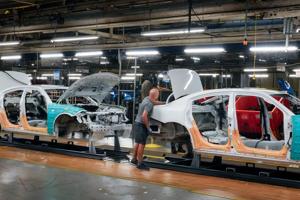Top Stories
Restaurant Brands Surges Past Sales Estimates Amid Fast-Food Demand

UPDATE: Restaurant Brands has just announced a significant surge in quarterly revenue, beating estimates as fast-food demand strengthens. In the second quarter, the company reported $2.41 billion in revenue, exceeding analyst predictions of $2.32 billion. This remarkable performance comes as the fast-food sector experiences a rebound driven by innovative marketing strategies.
Officials confirmed that aggressive advertising campaigns, including partnerships with blockbuster movies like “How to Train Your Dragon” and collaborations with actor Ryan Reynolds, have attracted customers back to Burger King and other brands in the U.S. and international markets. This strategic push is particularly crucial as consumer spending in the U.S. faces challenges amid ongoing tariff-related concerns.
To boost foot traffic, Burger King and other major fast-food chains, such as Yum Brands and McDonald’s, have introduced enticing value-meal deals starting at just US$5. The latest data shows that quarterly same-store sales at Burger King locations in the U.S., which is the company’s largest revenue-generating market, rose by 1.5%, a notable increase from only 0.1% a year ago.
Despite these gains, Restaurant Brands reported an adjusted profit of 94 cents per share, falling short of the 97 cents expected by analysts. This discrepancy is attributed to rising advertising expenses and increased costs associated with supply chain disruptions and commodities like beef and coffee.
In contrast, McDonald’s outperformed expectations with its global same-store sales, thanks to increased affordable meal bundles and promotions. Meanwhile, Taco Bell’s parent company, Yum Brands, faced challenges from muted consumer spending.
The company also reported a significant increase in sales for Tim Hortons, which stabilized in the quarter ending on June 30 following a dip in May due to lower demand. Comparable sales in Restaurant Brands’ international segments, which encompass chains like Burger King and Popeyes, rose by 4.2%, compared to a 2.6% increase the previous year.
However, the company’s total operating costs saw an alarming rise of approximately 36% in the second quarter, up from a 16% increase a year prior. This escalation raises questions about profitability moving forward, especially as the fast-food industry navigates changing consumer habits.
As the fast-food landscape evolves, all eyes will be on Restaurant Brands to see how it continues to adapt and respond to ongoing market challenges. The next quarter will be critical, and investors and consumers alike are eager to see how these developments unfold.
Stay tuned for more updates as we monitor the rapid changes in the fast-food industry.
-

 World3 months ago
World3 months agoScientists Unearth Ancient Antarctic Ice to Unlock Climate Secrets
-

 Entertainment3 months ago
Entertainment3 months agoTrump and McCormick to Announce $70 Billion Energy Investments
-

 Science3 months ago
Science3 months agoFour Astronauts Return to Earth After International Space Station Mission
-

 Lifestyle3 months ago
Lifestyle3 months agoTransLink Launches Food Truck Program to Boost Revenue in Vancouver
-

 Technology2 months ago
Technology2 months agoApple Notes Enhances Functionality with Markdown Support in macOS 26
-

 Top Stories1 week ago
Top Stories1 week agoUrgent Update: Fatal Crash on Highway 99 Claims Life of Pitt Meadows Man
-

 Sports3 months ago
Sports3 months agoSearch Underway for Missing Hunter Amid Hokkaido Bear Emergency
-

 Politics2 months ago
Politics2 months agoUkrainian Tennis Star Elina Svitolina Faces Death Threats Online
-

 Technology3 months ago
Technology3 months agoFrosthaven Launches Early Access on July 31, 2025
-

 Politics3 months ago
Politics3 months agoCarney Engages First Nations Leaders at Development Law Summit
-

 Entertainment3 months ago
Entertainment3 months agoCalgary Theatre Troupe Revives Magic at Winnipeg Fringe Festival
-

 Politics1 week ago
Politics1 week agoShutdown Reflects Democratic Struggles Amid Economic Concerns





















